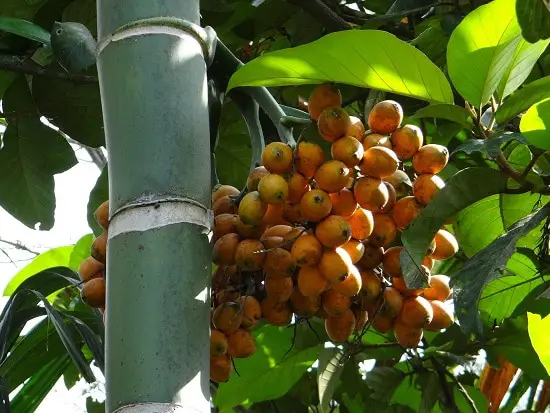Want to know How to Grow Betel Nut Tree and harvest the famous ‘Arecanut‘? Read on to know more about this useful palm!
Popularly known as Areca nut, Betel nut is a chewing fruit with major production and consumption in the Indian subcontinent. Let’s see How to Grow Betel Nut Tree and care for it in the right manner!
Botanical Name: Areca catechu
USDA Zones: 11-12
Difficulty: Moderately Difficult
Soil pH: 5.5 – 8 (Mildly Acidic to Alkaline)
Other names: Betel Nut Palm, Areca Palm, Areca Palm Plant, Areca Nut, Guam, Pohnpei, Chuuk, Yap, Palau, Kuanua, Pala, Lamekot, Supari.
Varieties of Betel Nut Palm

Two types of betel nut varieties are majorly grown in South-East Asian countries:
- White Betel Nut: Obtained by sun-drying the full ripe harvested nuts for two months.
- Red Betel Nut: Produced by harvesting the half-ripen green nut and removing the husk after boiling it.
Betel Nuts Growing Information
Native to South and Southeast Asia, Betel nut is widely cultivated in Sri-Lanka, India, Indonesia, Bangladesh, and the Philippines.
Betel Nut prefers to grow in tropical and subtropical regions, as it is not cold tolerant. It is a close relative to the coconut plant and belongs to the palm family. It can grow up to a staggering height of 50-70 feet and features a slender bark, edible medium-sized dark green leaves, and single-seed fibrous fruit that later produces nuts when harvested and processed.
Check out our article on growing Betel Leaf plant here!
How to Grow Betel Nut Tree?
You can grow this plant using the seed propagation or grafting method. For this, directly sow the seeds at the desired location. However, the process is time-consuming and requires efforts to take care of the seedlings and time before they start to bear areca nuts.
We highly recommend you to purchase healthy grown-up trees from nearby nurseries for planting. They will grow fast as compared to the palms grown from seeds, saving both your time and effort.
Requirements for Growing Betel Nuts Tree

Sun
The preferable location to grow betel is where the sunlight is abundant, a minimum of 4-5 hours of complete exposure is essential.
Soil
Betel plant can grow in a variety of soil, mildly acidic to alkaline soil with a pH range between 5-8. It thrives best in medium-textured loamy soil with a good moisture-holding capacity but drains well at the same time. Avoid growing it in heavy clay soil as it lacks sufficient drainage.
Water
Betal nut tree requires regular watering to grow properly and can’t withstand long periods of drought. Once affected by it, it takes 2-3 years for the plant to retrieve its normal growth rate and yield.
It is better to irrigate the plant in intervals of 4-10 days thoroughly. If water shortage is a problem, you can adopt modern-irrigation techniques like introducing water sprinklers and drip irrigating in your field.
Fertilizer
Fertilizer can help in improving the yield and growth of betel nuts. The recommended NPK ratio is 10-20-20. Keep the following precautions in mind while fertilizing betel nuts:
- Read the instructions on the label for proper dosage and application.
- Avoid over-feeding, as it can severely affect the yield and growth of the plant.
Tip: Monthly doses of 1/4 pound of fertilizer per plant during the growing season will make sure the optimum growth of betel nut.
Betel Nuts Tree Care
Pruning
Prune within 4-5 weeks of planting the betel nut tree. This ensures the plant receives adequate sunlight and air, thereby improving the growth rate. Kindly ensure you are not harming the branches while pruning. However, do bear in mind that pruning is not possible in the later stage of the betel nut tree.
Mulching
Mulching helps the betel nut plant to retain soil moisture and provides essential nutrients to facilitate its growth and yield.
Pests and Diseases
The resistance of the betel plant to pests and diseases is high if the care is proper. Keep your eyes on pests like Betelvine bug, Linear scale pest, Mealybug, Red spider mite, Aphids, and Black Fly.
The table below will help you in treating the diseases caused by the pests using chemical pesticides:

Harvesting and Betel Nut Processing

Harvesting the betel nut tree is done to obtain kernel from the raw fruits, which are further processed to produce betel nuts.
- Raw fruits are plucked from the betel nut tree.
- After plucking, the fruits are peeled to obtain the kernels. They are then boiled for at least 12 hours and sun-dried for 7-10 days to produce betel nuts.
Betel Nuts Growing Tips
- Instead of growing the plant from seeds, buy a grow up plant from a nearby nursery. It’ll save time and effort.
- Select a location with adequate sunlight and irrigation to ensure the plant grows easily.
- Remove excess shrubs and weeds near the betelnut plant.
- Betelnut plant thrives in a moderate climate and grows best when the temperature lies in the range 16-38 C (55-100 F).
Betel Nuts Benefits
Consumed in both dried and fresh form, Betel nut can be served raw, boiled, or roasted. It possesses a warm-spicy taste and consists of essential nutrients like arecoline, arecaidine, choline, gallic fatty acid, and tannins.
- It helps in preventing oral cavities.
- Improves focus by increasing concentration levels.
- Aids in curing indigestion.



What is the space between two bettle nut trees
6 to 7 ft
9 feet exact
Fertilizer/manure used for keeping the plant strong and less in height
Suresh chandra
What is the space between two bettle nut trees?
Minimum 9 feet
Fertilizer/manure used for keeping the plant strong and less in height?
Better you Use cow manure, green leaves for better yields
If you use NpK fertiliser avoid nitrogen
Sir can we grow bettle nut tree in between coconut tree…?